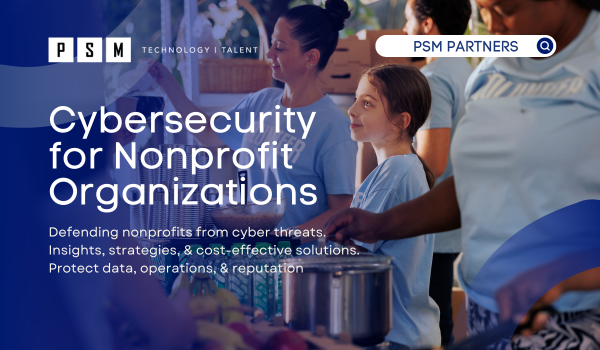Table of Contents
ToggleIn our modern era dominated by digital technology, the significance of cybersecurity cannot be overstated; affecting every sphere of activity and entity, including nonprofit organizations. Regrettably, nonprofit organizations have emerged as prime targets for cybercriminals today.
These nefarious actors often seek to exploit sensitive data, including generous financial contributions to nonprofits. Consequently, these organizations find themselves thrust into the spotlight, attracting unwanted attention. According to the 2023 Nonprofit Tech for Good Report, a concerning 27% of nonprofits worldwide have fallen prey to cyber-attacks.
Whether your organization has already been affected or you’re proactively seeking to fortify your defenses, this article is a comprehensive guide, offering invaluable insights and strategies to safeguard your nonprofit organization from cyber threats.
Why Are Nonprofits Vulnerable to Cyber-attacks?
Nonprofit organizations face unique cybersecurity challenges due to limited resources, lack of dedicated IT support, and the sensitive nature of the data they handle. These constraints often hinder their ability to implement robust security measures, leaving them vulnerable to cyber threats. Additionally, their interconnectedness with secondary organizations and reliance on third-party vendors create additional entry points for potential attacks.
Cybercriminals target nonprofits to access valuable donor information and research data. Despite the severity of these threats, nonprofits may need to pay more attention to their susceptibility and prioritize other mission-critical activities over cybersecurity. To mitigate these risks, raising awareness, investing in resources, and fostering a culture of cybersecurity consciousness are essential for nonprofits to protect their data, operations, and reputation.
Nonprofit Cyber Attacks
The issue of cybersecurity within nonprofit organizations has garnered significant attention over time. Cyber-attacks have been observed across organizations of varying sizes, impacting them to differing degrees.
Nonprofits, regardless of their scale, are susceptible to a wide array of cyber threats. From ransomware to phishing attacks and even sophisticated CEO fraud schemes, the threat landscape is diverse and pervasive across the nonprofit sector. While some organizations possess the financial resources to mitigate the substantial costs associated with such attacks, others find themselves exposed and vulnerable.
Here, we highlight two notable instances of nonprofits that have grappled with cyber-attacks, some of which you may recognize by name. These cases serve as poignant reminders of the critical importance of bolstering cybersecurity measures within the nonprofit realm.
1. Red Cross
A cyberattack targeted the International Committee of the Red Cross (ICRC), compromising personal data and confidential information of over 515,000 vulnerable individuals from 60 Red Cross and Red Crescent National Societies worldwide. Despite efforts to identify the perpetrators, the attack forced the shutdown of systems supporting the Restoring Family Links program, hindering the Red Cross and Red Crescent Movement’s ability to reunite separated family members.
2. Save the Children
Save the Children International had a cyberattack by a ransomware group that compromised parts of their network. Despite this, their operations continued unhindered as they investigated the breach and worked with authorities. The attackers, known as the BianLian hacker gang, claimed to have accessed significant data, including personal and financial information. This incident adds to the charity’s history of cybersecurity challenges, including a previous breach in 2020 involving donor information stolen by the same group.
Even major nonprofit organizations with significant financial and staff resources fall victim to cyber-attacks, and recovering from such incidents can be equally challenging for other entities. Despite this awareness, in a study done by NTEN resulted in a staggering 68% of nonprofits lack documented cybersecurity protocols for addressing breaches.
Risks and Consequences of Cyber Security Breaches
Recognizing the escalating importance of understanding cyber threats is essential for safeguarding the integrity and longevity of nonprofits, enabling them to fulfill their missions unhindered.
Exposure of Confidential Information
A cyber breach extends far beyond its initial impact, potentially revealing the identities of anonymous donors and compromising sensitive financial and governmental data pivotal to organizational operations.
Financial Implications
The repercussions of cyber-attacks ripple throughout the nonprofit sector, corroding trust among stakeholders and precipitating enduring consequences such as diminished fundraising prospects. Donors, alarmed by security breaches, may redirect their contributions to alternative causes or withdraw support entirely. According to a study by IBM Security, the average cost of a data breach reached an all-time high in 2023 of USD 4.45 million. This represents a 2.3% increase from the 2022 cost of USD 4.35 million. Taking a long-term view, the average cost has increased 15.3% from USD 3.86 million in the 2020 report.
Legal Ramifications
In the aftermath of a significant breach, nonprofits may find themselves embroiled in costly legal disputes, exacerbating financial strain. Furthermore, cyber incidents can trigger legal complications, including failure to meet governmental targets or contractual obligations, amplifying organizational vulnerability.
The Significance of Cybersecurity for Nonprofits
Cybersecurity transcends mere IT concerns for nonprofits; it represents a strategic investment in fostering vital trust relationships with donors and partners. In an era where a single phishing attack can jeopardize an entire nonprofit’s operations, cybersecurity awareness becomes imperative.
Listed below are prevalent cybersecurity challenges encountered by nonprofits:
Outdated Systems
Due to the donation-dependent nature of their funding, nonprofits often operate under stringent budgetary constraints. Consequently, some nonprofit organizations view computer systems solely as functional tools and neglect regular updates and enhancements. This lack of investment exposes organizations to myriad vulnerabilities and exploits, particularly concerning outdated operating systems.
Insufficient Training
Despite boasting specialists in highly specialized fields, nonprofits frequently lack dedicated IT departments tasked with safeguarding their data. The primary threat arises from a dearth of cybersecurity awareness. With no dedicated IT personnel, employees and partners struggle to stay abreast of evolving cyber threats, leaving organizations vulnerable.
Inadequate Security Protocols
Similarly, nonprofits typically lack comprehensive incident management strategies. Absence of robust protocols means cyber attacks can linger undetected for days, exacerbating the extent of damage inflicted.
Limited Resources Allocation
Nonprofits often allocate minimal resources to cybersecurity endeavors, viewing them as ancillary to their core missions. However, this underinvestment can have profound repercussions, potentially compromising donor trust and hindering fundraising efforts.
By addressing these cybersecurity challenges, nonprofits can bolster their resilience against evolving threats and safeguard their mission-critical operations. Prioritizing cybersecurity initiatives ensures that nonprofits can continue to serve their communities effectively while safeguarding sensitive data and maintaining the trust of stakeholders.
Nonprofit Cybersecurity: How to Secure Your Nonprofit Organization
Despite the misconception that effective cybersecurity requires significant financial investment, nonprofits can enhance their defenses against cyber threats with minimal spending. Here are some cost-effective measures they can implement:
- Regular Updates: Keep operating systems up to date to mitigate vulnerabilities.
- Cybersecurity Awareness Training: Invest in affordable training programs to educate staff on recognizing and mitigating cyber threats like phishing. Educate employees on cybersecurity awareness and best practices to ensure they understand the importance of security measures.
- Detailed Incident Response Plan: Develop a straightforward plan outlining steps to take during a cyberattack to minimize its impact.
- Formalize Policies and Procedures: Document policies and procedures, including incident response plans, to guide staff on security protocols.
By implementing these measures, nonprofits can strengthen their cybersecurity posture without straining their budgets. For organizations lacking the resources to manage IT internally, collaborating with an MSP can optimize budget allocation and enhance overall effectiveness.
Does My Nonprofit Need Cyber Liability Insurance?
In the realm of cybersecurity, the question often arises: do nonprofits need cyber liability insurance? These policies offer coverage for losses stemming from breaches affecting the nonprofit’s own information, as well as losses impacting third parties’ data, such as patients, clients, and donors. The scope of coverage ranges from expenses related to notifying affected parties to the costs of repairing hacked websites and even hiring public relations experts to mitigate reputational damage following a severe breach.
Moreover, cyber liability insurance can address business interruption costs in the event of a severe breach forcing temporary cessation of operations. While such outcomes may seem unlikely to some experts, having insurance coverage in place provides a safety net against unforeseen circumstances.
Before purchasing a cyber insurance policy, a nonprofit should consider:
Risk Assessment: Understand potential cybersecurity threats and the impact they could have on the organization’s operations and reputation.
Coverage Needs: Evaluate the specific types of coverage required, such as data breach notification costs, website restoration, and business interruption expenses.
Policy Features: Review policy details, including coverage limits, deductibles, and exclusions, to ensure they align with the nonprofit’s needs and budget.
Insurance Provider: Choose a reputable insurance provider with expertise in cyber liability insurance and a track record of supporting nonprofits.
Risk Management Practices: Implement effective cybersecurity measures and protocols to minimize risks and potentially reduce insurance premiums.
Legal and Regulatory Compliance: Ensure the selected policy complies with relevant laws and regulations governing data protection and privacy.
By carefully considering these factors, nonprofits can make informed decisions when selecting a cyber insurance policy to safeguard their operations against digital threats. While the thought of cyber-attacks may be unsettling, in today’s landscape, such incidents have unfortunately become commonplace.
Protect Your Nonprofit Organization With PSM
PSM Partners offers proactive Incident Response planning and corrective services in case of a security incident. Based in Chicago, IL, and service nonprofits nationwide, we guarantee comprehensive coverage for our clients, irrespective of their location. Our clients rely on us to provide proficient advisory services for cyber and risk management, conduct cyber readiness assessments, and promptly address any security incident. Recognizing the sensitivity and immediacy of these situations, we have established a tested response protocol that addresses not only the technical aspects but also the business requirements. To learn more about PSM’s Cybersecurity and Incident Response services, Contact us today.
Related Insights
Understanding the CDK Cyber Attack: What Happened and What Businesses Can Learn
Key Takeaways From the CDK Global Cyber Attack Massive DisruptionOn...
Read MoreCloud Engineer vs. Software Engineer: Understanding the Differences
In today’s rapidly evolving technology landscape, both cloud and software...
Read MoreCybersecurity Jobs to Hire in 2025: Building a Strong Team for the Future
The cybersecurity job market is evolving rapidly, driven by advancements...
Read MoreWhat Users Can Expect After The NetDocuments, Worldox Acquisition
Efficient document management is the key to the success of...
Read MoreAbout the Author

Caitlin Bergsma
Caitlin is an accomplished Marketing professional with an unwavering enthusiasm for the dynamic world of the IT industry. Caitlin's journey in the field began after earning her Bachelor's degree in Health Communications from Trinity Christian College, where she honed her skills and developed a keen eye for identifying market trends.





